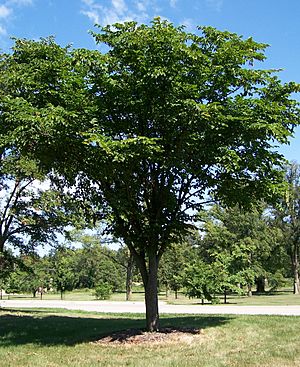Ulmaceae facts for kids
Quick facts for kids Ulmaceae |
|
|---|---|
 |
|
| Ulmus laciniata | |
| Scientific classification | |
| Kingdom: | |
| Division: | |
| Class: | |
| Order: | |
| Family: |
Ulmaceae
|
| Genera | |
|
Ampelocera Klotzsch |
|
The Ulmaceae family is a group of flowering plants that includes well-known trees like the elms (genus Ulmus) and the zelkovas (genus Zelkova). These plants are found in many parts of the world. They grow mostly in the northern temperate zone, which means areas with moderate climates, not too hot or too cold. You can also find them scattered in other places, but not in Australia or New Zealand.
Contents
What is the Ulmaceae Family?
The Ulmaceae family is a group of trees and shrubs. Scientists group plants into families based on their shared features. This family is part of the larger group called flowering plants, which means they produce flowers and seeds.
Where Do These Plants Grow?
Most plants in the Ulmaceae family live in the northern parts of the world. This includes places like North America, Europe, and Asia. They prefer areas where the weather changes with the seasons, having warm summers and cool or cold winters. Some types can also be found in warmer, tropical areas, but they are less common there.
What Do Ulmaceae Plants Look Like?
Ulmaceae plants are usually trees, but some can be shrubs. They have distinct features that help identify them.
Leaves and Branches
The leaves of Ulmaceae plants are often simple, meaning they are not divided into smaller leaflets. They usually grow in an alternating pattern along the branch. This means one leaf grows on one side, then the next leaf grows on the opposite side a little further up. The edges of the leaves are often serrated, which means they have small, saw-like teeth.
Flowers and Fruits
The flowers of these plants are usually small and not very showy. They often appear before the leaves in spring. Many Ulmaceae plants are pollinated by the wind, so they don't need bright colors or strong scents to attract insects. The fruits vary, but for elms, they are often small, flat, and winged. These winged fruits are called samaras and help the seeds travel far on the wind.
Important Members of the Family
Two of the most famous groups within the Ulmaceae family are elms and zelkovas.
Elms (Ulmus)
Elms are large, beautiful trees known for their graceful, spreading branches. They have been popular shade trees in cities and parks for centuries. There are many different types of elms, native to various parts of the world. Sadly, many elm trees have been affected by a serious disease called Dutch Elm Disease.
Zelkovas
Zelkovas are another important group of trees in this family. They look a bit like elms and are often used as ornamental trees in gardens and along streets. They are known for their attractive bark and strong wood. Zelkovas are native to parts of Asia and Europe.
Why Are Ulmaceae Plants Important?
Ulmaceae plants are important for several reasons. Their wood is strong and durable, making it useful for furniture, flooring, and other building materials. Elms, in particular, have been valued for their timber. These trees also provide shade, especially in urban areas, helping to keep cities cooler. They offer homes and food for many animals, including birds and insects.
Challenges for Elms
One of the biggest challenges for elm trees is Dutch Elm Disease. This is a serious fungal disease that is spread by bark beetles. It has caused the death of millions of elm trees around the world, especially in North America and Europe. Scientists are working hard to find ways to protect elm trees and develop new types that are resistant to the disease.
See also
 In Spanish: Ulmáceas para niños
In Spanish: Ulmáceas para niños

